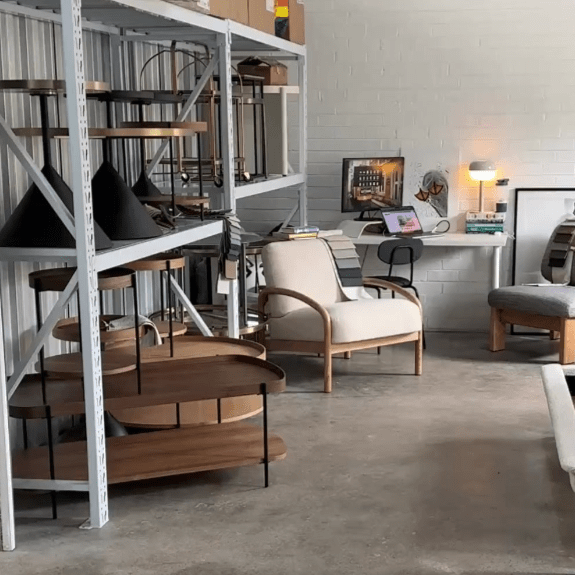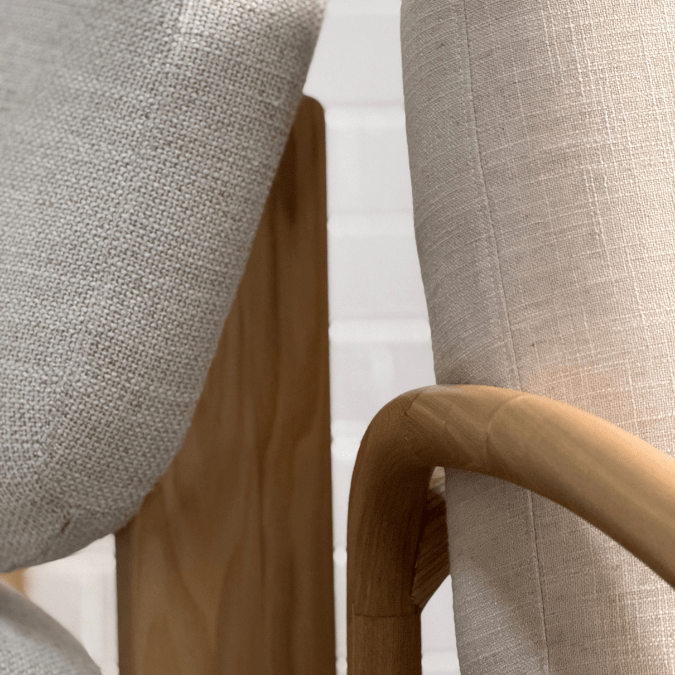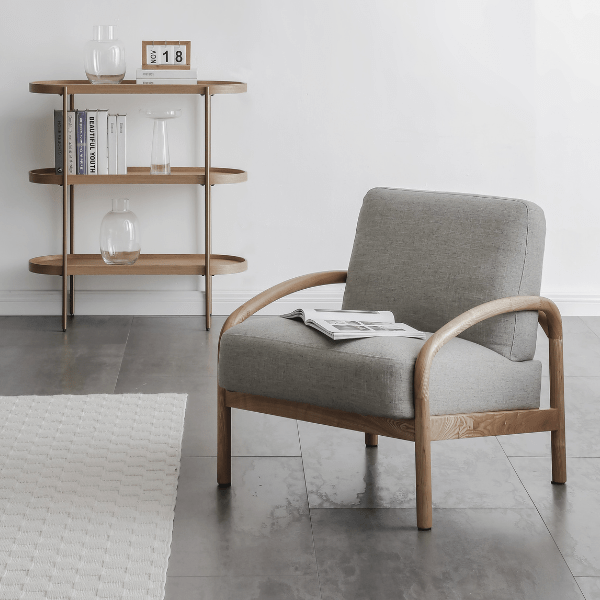FAQs & Furniture Product Care
At Seek & Ramble, you can find all the information you need to know about our furniture, wall art, & services.
Our helpful tips and assembly instructions will provide you with everything required for successful product installation. We have also complied tips on how to best care for materials such as glass, timber, and metal.
From material finishes to shipping dimensions, we have detailed product information so you can be sure that whatever your style, we have the perfect piece of furniture or wall art for you.
Material Care Information
Lucero Oil Timber Finish
Caring for a Lucero oil-finished timber product with natural oils (like hardwax oil or linseed/tung oil blends)—requires some special attention to preserve its appearance, feel, and longevity. Here's a complete guide:
Daily & Routine Care
Wipe Spills Promptly: Oil finishes are not as impervious as polyurethane. Wipe up water, wine, oil, or acidic foods (e.g., lemon juice) immediately to prevent staining or etching.
Use a Damp Cloth Only: Clean with a *barely damp* microfiber or soft cotton cloth. Avoid soaking or leaving moisture on the surface.
Mild Soap for Cleaning: If needed, use a mild, pH-neutral soap (like castile soap) diluted in water. Avoid harsh detergents or chemical cleaners.
Protecting the Finish
Use Coasters, Placemats & Trivets: Always protect the surface from hot dishes, water rings, and cutlery marks.
Avoid Plastic Covers: Plastic can trap moisture and cause clouding or discoloration over time. Use breathable natural materials.
Maintain Humidity: Wood expands and contracts with changes in humidity. Keep indoor humidity between 40–60% to avoid cracking or warping.
Periodic Maintenance (Every 6–12 Months)
Oil finishes wear gradually and should be refreshed to maintain protection and appearance.
What you’ll need:
A wood oil compatible with the original (often hardwax oil or natural furniture oil—check manufacturer recommendation)
Fine abrasive pad or 320–400 grit sandpaper (optional)
Lint-free cloths
Steps:
1. Clean the Surface: Remove dust and dirt thoroughly.
2. Light Sanding (if needed)**: Gently sand any rough or stained areas along the grain.
3. Apply Oil:
Use a cloth or sponge to apply a thin, even layer of oil.
Let it soak in (10–30 minutes depending on the product).
Wipe off any excess with a clean cloth.
Cure Time: Allow the table to dry undisturbed for 24–48 hours before use.
What to Avoid
* No silicone-based or multi-surface sprays (e.g., Pledge, Windex)
* No abrasive scrubbers
* No prolonged exposure to direct sun or heat sources
* No bleach, vinegar, or ammonia-based cleaners
If you know the -brand of oil- used on the Lucero table (e.g., Osmo, Rubio Monocoat, or another), I can give you product-specific care steps too.
Fabric Upholstery
Address spills promptly; do not leave them unattended.
Avoid using abrasive cleaners.
Immediately blot spills with a clean, absorbent white cloth.
The cleaning code may differ based on the selected fabric.
Exposure to direct sunlight may cause slight fading.
Seek professional guidance for stains before using cleaning solutions.
Vacuum upholstery regularly. Pilling is classified as wear and tear and is not a warranty manufacturing defect.
Fiber pills can be carefully removed with a battery operated pilling tool, available from most haberdashery stores.
General Maintenance
Vacuum Regularly: Dust and dirt can settle into the fabric fibres, leading to wear over time. Vacuum your upholstered chairs at least once a week using the upholstery attachment.
Rotate Loose Cushions: If your chair has removable cushions, rotate them regularly to ensure even wear and prevent sagging.
Spot Cleaning
Blot, Don’t Rub: If you spill something, immediately blot the area with a clean, dry cloth. Rubbing can push the stain deeper into the fabric and damage the fibres.
Use a Mild Soap Solution: Mix a small amount of mild dish soap with lukewarm water. Dampen a clean cloth with the solution and gently blot the stain. Avoid soaking the fabric.
Test Before Cleaning: Always test any cleaning solution on a hidden area of the fabric to ensure it doesn’t cause discolouration or damage.
Timber
Always clean with a soft, damp cloth — never use harsh or abrasive cleaners.
Wipe up spills immediately using a clean, absorbent cloth or paper towel.
Avoid direct sunlight. Prolonged exposure may fade the finish or cause discolouration over time.
Use coasters, placemats, and protective pads to prevent marks, scratches, or moisture damage from hot or acidic items (like citrus).
Metal
Powder-coated or vacuum plated metal can be cleaned with mild, non-abrasive products.
After cleaning, always wipe the surface with a clean, soft cloth to remove residue.
Avoid acidic substances (like lemon juice) coming into contact with the finish.
PU and Engineered Wood
Note – use non-abrasive furniture cleaners to ensure your table receives the best care.
Always read the label of cleaning products to ensure suitability before using.
Spills should be soaked up immediately with a clean, absorbent soft cloth or paper towel.
Mild cleaning products can be safely applied to the table surface. Just be sure to wipe the solution with a clean, soft cloth.
Avoid putting acidic material, such as lemon juice, onto your tabletop.
Keep product out of direct sunlight. The finish may lighten or degrade if exposed to harsh sunlight.
Wipe surface with a damp cloth. Avoid the use of household chemicals and cleaners.
Spills must be soaked up immediately with a clean absorbent cloth or paper towel.
We recommend the use of coasters and placemats to prevent damage.
Keep out of direct harsh sunlight as this may cause fading.
Glass
Clean with a soft cloth and standard glass cleaner or a microfibre cloth designed for glass.
Use coasters and placemats to help prevent scratching.
Never sit, stand, or lean on glass surfaces.
Do not place glass directly on hard surfaces during assembly or styling to avoid cracks or chips.
Handle with care, especially when moving or assembling.
General Tips
Always test cleaning products on an inconspicuous area first.
Keep out of direct harsh sunlight as this may cause fading.
Veneer
Always clean with a soft, damp cloth — never use harsh or abrasive cleaners.
Wipe up spills immediately using a clean, absorbent cloth or paper towel.
Avoid direct sunlight. Prolonged exposure may fade the finish or cause discolouration over time.
Use coasters, placemats, and protective pads to prevent marks, scratches, or moisture damage from hot or acidic items (like citrus).
Seek & Ramble FAQs
Do You Have A Showroom?
Sydney Studio
Our studio space is open by appointment! Come see our products up close, explore the details, and chat about your project. Whether you need styling advice or want to discuss your ideas, we’re here to help. Book your visit today.
Where Do You Ship?
We ship all Wall Art Worldwide. Furniture ships Australia wide from Sydney. We ship most furniture items to the USA & Canada from our Chicago warehouse.
Do You Customise?
We may be able to make small changes, otherwise, most of our range is as shown. We're happy to answer any questions you may have so get in contact via the online form below.
What Is Fluted Glass?
Fluted glass refers to glass panels or surfaces that have decorative vertical grooves or channels running along them. It is a popular design element used in modern furniture and architecture.
Overall, fluted glass offers a combination of visual, functional, and textural benefits, making it a popular choice for modern furniture design.
What Is A PU Coating & Manufactured Wood?
PU coating, short for polyurethane coating, is a protective finish applied to manufactured wood surfaces. It is a type of synthetic material derived from polyurethane polymers. PU coating offers several benefits, including enhanced durability, moisture resistance, and increased resistance to scratches, stains, and UV damage.
It provides a consistent appearance and helps protect the underlying wood from wear and tear. PU coatings are commonly used in furniture manufacturing and other applications where a protective, attractive finish is desired.
What Is A Powder Coated Finish?
A powder coated finish is a type of coating that is applied to various surfaces as a dry powder. It is a popular method used to provide a durable and decorative finish to metal, ceramic, and even some plastic substrates.
Powder coated finishes offer several advantages. They provide excellent resistance to chipping, scratching, and fading, making them highly durable. They also offer better protection against corrosion and weathering compared to traditional liquid paints.
What Is Manufactured Wood & Timber Veneer?
Manufactured wood, also known as engineered wood or composite wood, refers to a type of wood product that is created by binding together wood fibres, particles, or veneers with adhesives under heat and pressure.
Manufactured wood offers several advantages, including increased stability, uniformity, and resistance to warping and shrinking. Timber veneer surfaces in furniture involve the application of a thin layer of real wood veneer onto the surface of a furniture piece.
Veneers are slices or sheets of real wood, typically obtained from a log through a process called slicing or peeling. These veneers are then applied to the manufactured wood substrate or other surfaces using adhesives.
Timber veneer surfaces provide the appearance and feel of real wood while offering a natural wood aesthetic with variations in grain patterns and colours.
What is Vacuum Plated Finish?
Vacuum plated finish, also known as vacuum metallisation or physical vapour deposition (PVD), is a surface coating technique used to apply a thin layer of metal onto a substrate. In this process, a vacuum chamber is utilised to evaporate the metal material, which then condenses onto the surface of the object, creating a metallic coating.
The result is a durable and visually appealing finish that replicates the appearance of various metals, such as chrome, gold, or silver. Vacuum plated finishes are commonly employed in automotive parts, decorative items, electronics for their decorative and functional properties, and of course, furniture items.
What is the Difference Between Vacuum Plated and Painted Finishes?
Vacuum plated finishes involve depositing a thin layer of metal onto a substrate through a vaporisation process. This creates a metallic appearance that mimics the properties of different metals. Vacuum plating offers high durability and can withstand wear, while providing an authentic metal-like finish
Painted finishes, on the other hand, involve the application of liquid paint or coating onto a surface. Painted finishes offer a broader range of colour options and can achieve various textures and effects.
However, painted finishes may not have the same metallic or reflective properties as vacuum plated finishes. They may also require additional protective coatings to enhance durability.
In summary, vacuum plated finishes utilise a vaporisation process to deposit metal onto a substrate, while painted finishes involve applying liquid paint or coating. Vacuum plated finishes offer a metallic appearance with high durability, whereas painted finishes offer a wider range of colour options but may require additional protection for durability.
Are Pedestal Tables Sturdy?
The drum base of the pedestal tables feature a concealed weight that provides extra stability at the bottom of the table. This means most of the table weight is contained at the base and provides better stability.
Do You Offer Wholesale Or Trade Accounts.
We do not have anything in place just yet but this is coming. If you are interested, contact us below.
Do You Offer Influencer Or Partner Collabs?
In short, yes. If your brand aligns to ours, we'd be happy to chat more. Contact us below.
Product Cleaning Tips
Glass
Always read the label of cleaning products to ensure suitability before using.
Glass can be cleaned with a soft cloth and glass cleaner, or with a microfibre glass cleaning cloth. Use coasters or placemats to prevent scratches on the glass.
Take care when handling glass.
Do not sit, stand or lean on any glass units. Do not place the glass directly onto hard surfaces.
Note – use non-abrasive furniture cleaners to ensure your table receives the best care.
Metal
Use non-abrasive furniture cleaners to ensure your table receives the best care. Always read the label of cleaning products to ensure suitability before using.
Spills should be soaked up immediately with a clean, absorbent soft cloth or paper towel. Mild cleaning products can be safely applied to the metal's surface. Just be sure to wipe the solution with a clean, soft cloth. Do not place sharp objects atop your metal table.
Avoid putting acidic material, such as lemon juice, onto your metal surfaces.
Timber Veneer
Always read the label of cleaning products to ensure suitability before using. Spills should be soaked up immediately with a clean, absorbent soft cloth or paper towel.
Avoid putting acidic material, such as lemon juice, note – use non-abrasive furniture cleaners to ensure your table receives the best care.
Keep product out of direct sunlight.
The timber veneer or wood will lighten and surface finishes may degrade if exposed to bright sunlight. Wipe timber veneer or wood with a damp cloth. Avoid the use of household chemicals and cleaners.
Spills must be soaked up immediately with a clean absorbent cloth or paper towel.
We recommend the use of coasters and placemats to prevent damage.



